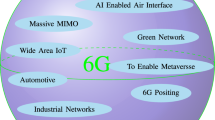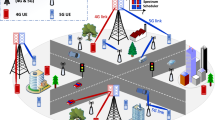Abstract
This paper analyzes the performance of the OFDM diversity systems with the spatial fading correlation when the network includes an RF repeater. In case of OFDM transmission, since the combining scheme is usually employed in the frequency domain, the correlation between different subchannels should be considered. In a multipath channel, correlation varies over subchannels depending on the channel delay profile and the spatial correlation between each individual delayed paths. In this study, a multipath channel is constructed by the repeated signal instead of natural multipath due to cluttered environments and the system performance with spatial correlation per subcarrier is evaluated. Previously, it is reported that the effect of correlation can be reduced by the Time Shifted Sampling (TSS) technique which relies on the multipath diversity. Numerical results indicate that the TSS technique is also effective in reducing the effect of correlation for the multipath channels constructed by the repeaters.
Similar content being viewed by others
References
Patwary, M. N., Rapajic, P. B., & Oppermann, I. (2005). Capacity and coverage increase with repeaters in UMTS urban cellular mobile communication environment. IEEE Transactions on Communications, 53(10).
Raulefs, R., & Damman, A. (2008). Repeating or relaying in wireless systems. In Proceedings of IEEE Wireless Communications and Networking Conference pp. 506–510.
Qingyu, M., & Osseiran, A. (2008). Performance comparison between DF relay and RF repeaters in the cellular system. In Proc. IEEE Vehicular Tech. Conference (pp. 2021–2025).
Repeater issues for MBWA. IEEE 802.20 Working Group on Mobile Broadband Wireless Access.
Kizilirmak C., Sanada Y. (2008) Multipath Diversity through Time Shifted Sampling for Spatially Correlated OFDM-Antenna Array Systems. IEICE Transaction on Fundamentals E91A(11): 3104–3111
Salz J., Winters J.H. (1994) Effect of Fading Correlation on Adaptive Arrays in Digital Mobile Radio. IEEE Transaction on Vehicular Technology 43(4): 1049–1057
Fulghum, T. L., Molnar, K. J.,& Duel-Hallen, A. (2002). Jakes Fading model for antenna arrays Incorporating Azimuth Spread. IEEE Transaction on Vehicular Technology, 51(5).
Patel C. S., Stuber G. L., Pratt T. G. (2006) Statistical Properties of Amplify and Forward Relay Fading Channels. IEEE Transaction on Vechicular Technology 55(1): 1–9
Nabar R. U., Boelcskei H., Knueubhueler F. W. (2000) Fading relay channels: Performance limits and space-time signal design. IEEE Journal of Selected Areas in Communication 22(6): 1099–1100
UTRA Repeater: Planning Guidelines and System Analysis. 3GPP TR 25.956.
Ahumada L., Feick R., Valenzuela R. A., Morales C. (2005) Measurement and characterization of the temporal behavior of fixed wireless links. IEEE Transaction on Vehicular Technology 54: 1913–1922
Pajusco, P. (1998). Experimental Characterization of DOA at the base station in rural and urban area. In Proceedings of the IEEE Vehicular Technology Conference VTC 2003 Spring, 2, pp. 993–997.
Author information
Authors and Affiliations
Corresponding author
Rights and permissions
About this article
Cite this article
Kizilirmak, R.C., Sanada, Y. Performance Analysis of OFDM Repeater Networks with Spatial Fading Correlation. Wireless Pers Commun 56, 573–582 (2011). https://doi.org/10.1007/s11277-010-9990-y
Published:
Issue Date:
DOI: https://doi.org/10.1007/s11277-010-9990-y




